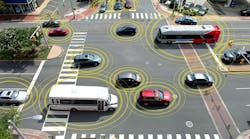No, it’s not AM, FM, SiriusXM, HD, or a combination. And it’s not the GPS radio in your nav system or the Bluetooth audio accessory. Or even a CB radio. Instead, it’s likely going to be something called C-V2X, essentially shorthand for “cellular-vehicle-to-everything.”
This new radio will provide two-way communications with other nearby vehicles as well as the cellular network. You won’t personally be doing the communicating, but your vehicle radio will.
Your Government in Action
The whole idea is a part of the National Highway Transportation Safety Administration’s (NHTSA) goal to improve vehicle safety by having cars and trucks in close proximity communicating with one another. Called vehicle-to-vehicle (V2V) communications, this feature shows great promise in helping to reduce deaths and injuries, avoid crashes, ease traffic congestion, and improve the environment.
V2V radios are transponders that let vehicles exchange information automatically about their location, speed, direction, and other data with other vehicles within range, typically up to 300 meters. By exchanging standard data packets, the vehicles can analyze them, determine potential threats, and provide early warnings to the driver with audible or visual alerts. Future tie-ins to current advanced driver-assistance systems (ADAS) and self-driving vehicles are possible.
While the main feature of the plan is V2V, these new radios can also communicate with outside entities such as a traffic information infrastructure (V2I) that provides traffic updates, construction notices, weather warnings, and other relevant trip data. Other links are possible, opening the opportunity for vehicles to communicate with almost anything (V2X).
The government and industry have been working on this system for decades. It developed a radio technology called dedicated short-range communications (DSRC) years ago. The wireless technology, similar to Wi-FI OFDM standards, is designated as IEEE 802.11p and operates in the 5.9-GHz spectrum.
In 1999, the Federal Communications Commission (FCC) dedicated a 75-MHz block of spectrum to DSRC. Radios were designed and built and tested, but nothing else happened. A few automakers showed interest, but overall acceptance was lacking and adoptions were few. Now, 20 years later, the whole idea of V2V hasn’t progressed. However, that may be about to change.
New Life for an Old Idea
A new similar radio technology called cellular-V2X has come along to challenge DSRC. C-V2X is based on 4G LTE and ultimately the 5G standards. It too would operate in the 5.9-GHz spectrum assignment. And it will use the existing cellular system to communicate with whatever infrastructure will be developed, thus avoiding the cost of creating the infrastructure for DSRC.
A direct communications mode to enable V2V was created by the Third Generation Partnership Project (3GPP), the developer of cellular standards, in Release 12. 3GPP added LTE Broadcast in Release 9, a feature also applicable to C-V2X. 3GPP introduced C-V2X in Release 14 of the 5G standards.
Some additional benefits of C-V2X over DSRC include an extended communications range of up to several miles and an upgrade path with 5G in the future. The lower latency of 5G will provide faster reaction times for drivers as well as any ADAS.
So, C-V2X is challenging DSRC for the V2V and V2X standard. It has found wide support not only with the cellular carriers, chip manufacturers, and test-instrument companies, but also with many auto manufacturers. After two decades of contemplation, some progress is being made to finally incorporate V2V/V2X into modern vehicles.
C-V2X Spectrum
In a recent speech, FCC Chairman Ajit Pai, provided almost direct approval for C-V2X with new frequency allocations in the 5.9-GHz band. His actions benefit both Wi-Fi and the V2X movement. Take a look at his reassignment of the previously allocated 75-MHz of DSRC spectrum.
The lower 45-MHz piece of spectrum will go to unlicensed service, namely Wi-Fi. With the 2.4-GHz Wi-Fi band full and crowded, more spectrum is needed to keep pace with Wi-Fi developments. New faster standards like 802.11ac (Wi-Fi 5) and 802.11ax (Wi-Fi 6) operate in the 5-GHz band and require more bandwidth. This is a great use of that untouched spectrum, given that over half of all internet connectivity is via Wi-Fi.
Chairman Pai also proposes that the upper 20 MHz of the 75 MHz go to C-V2X. The remaining 10 MHz will go to DSRC or C-V2X, whichever ultimately wins that competition. This decision apparently doesn’t kill the DSRC movement. One proposal is to adopt both technologies, with DSRC handling V2V and C-V2X handling the V2I/V2X. Chipsets incorporating both radios have already been developed.
These proposed assignments will be put into a Notice of Proposed Rulemaking for the Commissioner’s approval at this week’s meeting (Dec. 12). This should be signal enough for the auto industry and others to move quickly to bless C-V2X and adopt it. Otherwise, the NHTSA could mandate it to move things along.
Chairman Pai’s announcement certainly gives support to C-V2X. And feedback from government, industry, research firms and consumers groups has been overwhelmingly positive. Maybe that will get the auto industry and the NHTSA some incentive to make a decision regarding the whole V2X program. Quit talking about it and decide which technology to pursue.
In the meantime, it looks like Europe may have already made a decision. Volkswagen is building DSRC, or the European version ITS-G5, into its new VW Golf. It’s using NXP’s SAF5400 modem and TEF5100 transceiver that handle all of the IEEE 802.11p standard’s features upon which DSRC is based. This 5.9-GHz device also complies with the IEEE 1609.4 and AEC-Q100 grade 2 standards.
The whole V2V/V2X idea is basically a good one. However, the V2X movement is stalled until a decision is made. Why drag it out? Two workable technologies are available right now.
Almost all parties involved agree that it will save millions of lives and crash occurrences will decline. That’s the good news. The bad news is that it will take years (decades?) for enough C-V2X equipped vehicles to populate the roads to make this work. Let’s get started.



